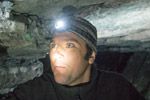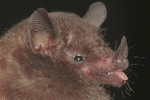Species monitoring can be a very invasive form of research. For instance, bird-banding – in which identification bands are placed around birds’ legs to track their movements – usually requires first catching them in nets. However, the use of non-invasive techniques made possible through advancements in technology has been on the rise. A new study published in Ecological Informatics examined one such technique: an innovative and inexpensive non-invasive monitoring tool, known as acoustic surveying.
The study tested the effectiveness of acoustic surveying as a species monitoring approach by assessing the possible impacts on bats by future construction activities at the University of Southern Denmark. Although the method was tested on bats, it can also be applied for the study of birds and insects. The researchers found it was very useful for species monitoring, providing significant insights into bat behavior and species distribution, while minimally impacting their lives.

By using acoustic surveying, the researchers were able to identify two species of bats that hadn’t before been observed near the survey site in southern Denmark, such as this pond bat (Myotis dasycneme). Photo by Gilles San Martin.
The scientists recorded the bats’ calls over an extended period of time, and examined them in respect to seasonal variation, sunset and sunrise times, moon brightness, and weather conditions, all of which affect bat behavior. Scientists regard bats as “bioindicators” of high biodiversity. By gaining a better understanding of bat behavior, researchers can further understand how well an ecosystem is faring.
“Bats require a high quality habitat — i.e., an area with diverse vegetation, water and roosting possibilities,” Dr. Annemarie Surlykke, co-author of the study, told mongabay.com “That is not only important for bats, but for animal diversity in general, and therefore many bats would imply possibility for many animals (birds, amphibians, insects) in that particular area.”
 The researchers recorded and identified the calls of Nathusius’ pipistrelles (Pipistrellus nathusii) via acoustic surveying. |
The study broke down the recorded noises into separate “events,” in which some were categorized as “bat events” — or noises the researchers believed to be true bat calls– and “non-bat events.” Its findings showed sunrise and sunsets were associated with lots of bat activity, and that there was significant variation within day-to-day calls, which the researchers attributed to precipitation. They analyzed events before, after, and during rainfall and found some surprising patterns. Previously, scientists thought bats were not very active during rainfall, but Surlykke and her team discovered that bat events did happen throughout a period of rain. However, due to the noise from rain, the researchers had a harder time determining whether or not noises were actually bat calls. Another finding from the study that contradicted previous research was that a larger than expected proportion of recorded calls were social in nature rather than for echolocation.
The researchers were also surprised to hear bat calls from two species that were not known to inhabit the area: Nathusius’ pipistrelles (Pipistrellus nathusii) and pond bats (Myotis dasycneme).
The study estimates that 30 percent of candidate bat call events will turn out to be non-bat events upon further analysis. Future advances in technology and incorporation of long-term monitoring techniques will help improve the performance of acoustic surveying, such as reducing the number of false positives. The authors suggest several specific alterations to the approach for future research, including marking the start and end of an event and incorporation of weather data (e.g., humidity, temperature, illumination level, etc.).
According to Surlykke, despite the availability of recording devices, using them to collect acoustic data and analyze behavior in a noninvasive way is new. This study is at the forefront of non-invasive research, and demonstrates that acoustic surveying can be an effective way to conduct species monitoring. Future expansions on this approach may not only allow it to provide information on reproductive strategies and foraging behavior, but may also further our understanding of human impacts on the environment.
Citations:
- Surlykke, A., Andreassen, T., & Hallam, J. (2014). Long-term acoustic surveying of bats. The Journal of the Acoustical Society of America, 135(4), 2241-2241.
Related articles
The matrix matters: scientists find surprising biodiversity between forests
(05/20/2014) In human-dominated countryside areas, forests are often fragmented and scattered among a matrix of developments such as plantations and pastures. Scientists have long overlooked the habitat value of these matrices. However, according to a recent study published in Nature, the biodiversity of altered countryside areas that exist between islands of fragmented forests can be significant and deserving of conservation attention.
Scientists discover giant sperm fossilized in bat feces (PHOTOS)

(05/15/2014) In a cave in Australia, researchers from the University of New South Wales discovered giant fossilized sperm. The sperm were produced 17 million years ago by a group of tiny, shelled crustaceans called ostracods, making them the oldest fossilized sperm ever found. The results were published recently in the Proceedings of the Royal Society B.
The remarkable story of how a bat scientist took on Russia’s most powerful…and won

(04/28/2014) In a country increasingly known for its authoritarian-style crackdown on activists and dissidents, a bat scientist has won a number of impressive victories to protect the dwindling forests of the Western Caucasus. For his efforts, Gazaryan was awarded today with the Goldman Environmental Prize, often called the Nobel Prize for the environment, along with five other winners around the world.
City lights threaten rainforests by deterring bats

(04/09/2014) Fruit-eating bats play an important role in forest regeneration, collecting and spreading seeds far and wide. However, human development may be stymying bat-mediated dispersal. In a new study, researchers found that fruit bats avoid feeding in light-polluted areas, which may significantly affect forest growth.
New bat species discovered in Brazil leaves another at risk

(11/15/2013) A team of researchers has discovered a new species of bat in Brazil, which has put a previously known species, Bokermann’s nectar bat (Lonchophylla bokermanni), at risk of extinction. Long thought to comprise one species, the bat populations of the Atlantic Forest and the Cerrado – the tropical savannah of Brazil’s interior – are in fact distinct from one another, according to a new study in Zootaxa. Scientists now say the Atlantic Forest’s population represents a newly described species, which they have dubbed Peracchi’s nectar bat (Lonchophylla peracchii).